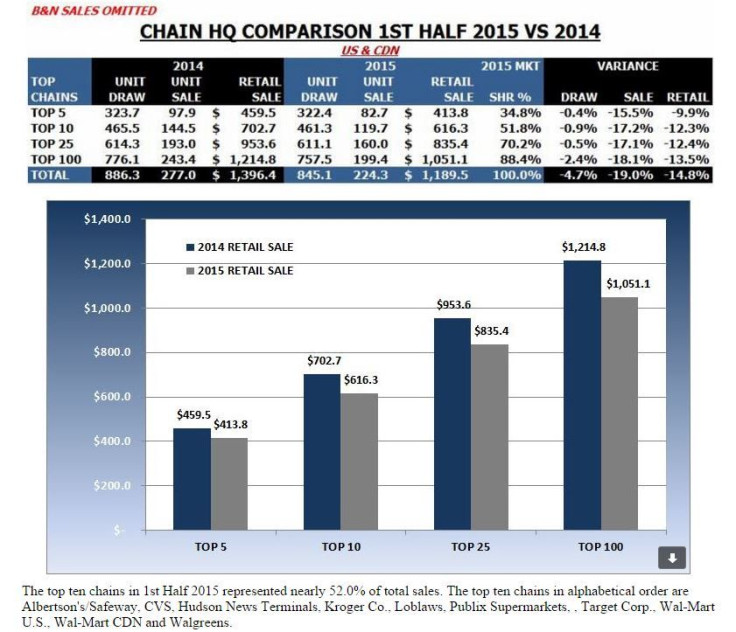iPhone Havoc: Magazine Newsstand Sales Are Now Half Of What They Were In 2007
The news just keeps getting worse for the magazine industry. According to MagNet, which tracks magazine sales in the U.S. and Canada, newsstand magazine sales declined nearly 14 percent in the first half of 2015, continuing a yearslong slump. Unit sales are expected to generate $2.5 billion this year, about half of what they made in 2007, the year Apple Inc. released its first iPhone.
“The newsstand channel is fragile,” a report accompanying the numbers read. “The dollar sales decline that we have been experiencing in magazine sales at newsstand over the last eight years appears to be accelerating.”
Last year, the magazine industry was dealt a grave blow when Source Interlink, the largest distributor in the country, filed for bankruptcy. That disappearance is plainly visible in the statistics released Tuesday. Forty million fewer copies were distributed to newsstands in the first half of this year compared to last. Despite that relative scarcity, unit sales efficiencies, a number which reflects sales health, plunged to the lowest number MagNet has ever recorded, 26.8 percent.
Retail sales declined in all but four categories: Social and literary magazines, a relatively niche category, leapt nearly 24 percent, games and puzzles increased 5 percent, outdoors ticked up 6 percent and lifestyle, which essentially held flat, inched up 0.7 percent. Nearly every other category experienced a double-digit decline, with teen- and children-focused magazines (down 30 percent), crafts (down 25 percent) and automotive (down 24 percent) experiencing the biggest drops.
Because actually finding a magazine to purchase has become increasingly difficult, publishers are now more reliant on retailers like Albertson's, Target and Walmart for their sales. While those sales also declined through the first half of 2015, they now represent more than half of all newsstand revenue in the United States and Canada.
Newsstand sales of magazines have been in decline for the past eight years, as more people access information and content on mobile devices. Eight years after the launch of the iPhone, the first consumer-facing smartphone, the overwhelming majority of Americans own cell phones, and nearly two-thirds of them own smartphones, according to the Pew Research Center. In its previous report, which charted first-quarter newsstand sales, MagNet acknowledged that the ubiquity of smartphones and other Internet-connected mobile devices had effectively changed the media consumption habits of its customer base.

Typically, when trade groups release reports filled with sales statistics, the report authors focus almost exclusively on the positives, sometimes contorting themselves into peculiar shapes to highlight the reasons for optimism. Six months into 2015, it appears the magazine industry’s print sector has run out of twists.
“Over the last eight years of sales declines, MagNet has always attempted to find and highlight positives trends within the overall negative outlook,” the report’s final paragraph reads. “There are still some publishers who are having sales increases, and others who are faring better than the overall industry, either by increasing their title mix and cover prices or focusing on higher-priced specials.
“We applaud them for their creativity and success, and for their continual focus on newsstand.”
© Copyright IBTimes 2024. All rights reserved.





















